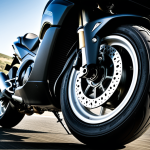Essential Understanding of Kawasaki ZX-10R ABS
The Kawasaki ZX-10R ABS function is pivotal in enhancing rider safety by preventing wheel lock-up during sudden braking. At its core, the Anti-lock Braking System (ABS) constantly monitors wheel speed sensors. When it detects a rapid deceleration indicating imminent wheel lock, the system rapidly modulates brake pressure. This modulation prevents skidding, maintaining traction and allowing the rider to retain control.
A major benefit of the ABS on the ZX-10R is its ability to maximize braking efficiency during high-performance riding. This is especially crucial on wet or slippery surfaces, where losing grip is a constant risk. The system enables more aggressive braking without compromising stability, boosting rider confidence.
In the same genre : Brighten Your Ducati Monster 1200: Pro Tips for Upgrading Your Lighting System for Improved Visibility
However, it’s important to understand the system’s limitations. While ABS improves safety, it doesn’t reduce stopping distances drastically on all terrains. For example, on loose gravel, anti-lock systems can sometimes increase stopping distance due to its intervention pattern. Additionally, ABS should never replace sound braking technique but instead complement it.
In sum, the Anti-lock Braking System basics on the ZX-10R provide an advanced safety net, carefully balancing effective deceleration with maintaining control — a necessity for this performance motorcycle.
Also to discover : Achieving Optimal Tire Air Pressure for Superior Stability in Your Piaggio MP3: The Definitive Handbook
Routine Maintenance for Reliable ABS Performance
Maintaining the Kawasaki ZX-10R ABS function is essential for consistent safety and performance. Regular ABS maintenance helps detect and prevent issues before they compromise braking efficiency.
Routine system checks should include inspecting wheel speed sensors for dirt or damage, as faulty sensors can lead to inaccurate ABS modulation. Cleaning these components carefully ensures accurate readings. Additionally, monitoring the ABS warning light during startup can quickly signal any faults requiring professional diagnostics.
The ZX-10R upkeep schedule recommends checking the ABS system every 6,000 miles or annually, whichever comes first. This interval includes a complete diagnostic scan to verify electronic control unit status and brake component wear. Keeping the entire braking system, including calipers and discs, in excellent condition supports reliable ABS function.
Avoiding contamination of brake fluid is also crucial; periodic fluid changes following Kawasaki’s guidelines prevent moisture buildup, which can degrade system responsiveness. Overall, strict adherence to reliability tips like thorough cleaning, sensor inspection, and timely servicing preserves the ABS’s role in enhancing braking control and rider confidence on the ZX-10R.
Best Practices for Brake Fluid Selection and Maintenance
Choosing the correct brake fluid is vital for maintaining the Kawasaki ZX-10R ABS function at peak performance. Kawasaki specifies the use of high-quality, DOT 4 brake fluid due to its higher boiling point and moisture resistance, which ensures consistent hydraulic pressure under extreme braking conditions. Using an improper fluid type can degrade braking response and risk ABS malfunction.
Brake fluid should be replaced at regular intervals—typically every 12 months or 6,000 miles. Over time, brake fluid absorbs moisture from the air, lowering its boiling point and potentially causing vapor lock during hard braking, compromising the Anti-lock Braking System basics. Fresh fluid maintains system responsiveness and safety.
When performing fluid changes, thorough bleeding is necessary to expel air bubbles that can diminish braking efficiency. Following the manufacturer’s bleeding procedure preserves proper fluid pathways and prevents spongy brake feel. This careful maintenance directly supports reliable ABS modulation.
In summary, prioritizing Kawasaki’s brake fluid recommendation and adhering to timely fluid replacement with proper bleeding practice ensures your ZX-10R’s ABS continues delivering dependable stopping power under all riding conditions. This best practice safeguards ABS function and your safety on the road or track.
Upgrading Brake Pads for Enhanced ABS Effectiveness
Enhancing the Kawasaki ZX-10R ABS function begins with choosing the right ZX-10R brake pads. Upgrading to premium performance brake pads designed for high friction and heat resistance improves the system’s response during emergency or aggressive braking. These pads maintain consistent contact and reduce fade, allowing the ABS to more accurately modulate brake pressure without delay.
Compatible brake pads often feature advanced materials such as sintered metal or carbon-ceramic composites, which offer better bite and durability over stock pads. This upgrade supports the Anti-lock Braking System basics by providing a more predictable braking feel. Riders experience shorter stopping distances and smoother ABS intervention.
When selecting pads, compatibility with the ZX-10R calipers and brake discs is crucial to preserve the intended ABS calibration. Incorrect pad choice can lead to uneven wear or altered brake feel, undermining ABS effectiveness. Installing upgraded pads also pairs well with following Kawasaki’s recommended ABS maintenance routines to ensure consistent performance.
In summary, investing in high-quality ZX-10R brake pads is a practical ABS upgrade. It directly enhances system responsiveness and rider confidence, especially in demanding riding scenarios where ABS performance truly matters.
Adjusting ABS Sensitivity and Response
Fine-tuning the Kawasaki ZX-10R ABS function allows riders to customize ZX-10R ABS settings for enhanced braking control. This adjustment is essential for achieving the ideal balance between safety and performance, especially when switching between street and track conditions.
ABS adjustment typically involves modifying the system’s sensitivity to wheel slip. Increasing sensitivity results in earlier ABS intervention, which is beneficial on slippery or wet roads to prevent lock-up. Conversely, reducing sensitivity delays ABS activation, offering more aggressive braking feel preferred by experienced riders on dry pavement or racetrack environments.
Manufacturers often provide ECU remapping or aftermarket controllers that allow precise ABS adjustment. These adjustments can recalibrate pressure modulation thresholds and response time, tailoring the system to rider preference and riding style.
However, altering ZX-10R ABS settings requires careful consideration. Overly aggressive adjustments can compromise safety by either disabling ABS interference too late or too early, defeating the purpose of the system. Testing changes gradually under controlled conditions ensures that the rider maintains confidence without sacrificing ABS benefits.
In summary, mastering ABS adjustment empowers riders to optimize the Kawasaki ZX-10R ABS function for variable conditions, improving both safety and braking performance.
Optimising Aftermarket Upgrades for ABS System
Selecting aftermarket ABS upgrades for the Kawasaki ZX-10R requires careful focus on compatibility and preserving the Kawasaki ZX-10R ABS function. High-quality ZX-10R performance parts such as enhanced wheel speed sensors and ECU tuning modules can improve the precision and responsiveness of the Anti-lock Braking System basics without disrupting factory calibration.
When integrating aftermarket ABS upgrades, ensure components seamlessly communicate with the original ABS controller to avoid faults or degraded performance. For example, upgraded sensors with extended signal range help maintain accurate wheel speed detection during aggressive riding. Similarly, advanced ECU remapping kits refine the modulation logic, allowing for finer control over brake pressure application.
Installation should follow manufacturer guidelines, and post-installation diagnostics confirm proper functionality. Riders should be mindful that some performance parts may require professional setup to align with the ZX-10R’s ABS algorithms. Ignoring this can lead to inconsistent ABS intervention or warning lights.
In summary, choosing compatible ZX-10R performance parts and carefully integrating aftermarket ABS upgrades enhances the motorcycle’s braking safety and performance. This approach supports continuous refinement while respecting the Anti-lock Braking System basics that Kawasaki engineered into the ZX-10R.
Real-World Techniques to Maximise ABS Efficiency
Effective braking technique is crucial to leverage the Kawasaki ZX-10R ABS function fully. Riders should apply steady, progressive brake pressure rather than abrupt or excessive force. This approach allows the Anti-lock Braking System basics to modulate brake pressure smoothly, preventing wheel lock and ensuring maximum control.
How can riders adapt ABS riding skills on different surfaces? On wet or slippery roads, gentle initial braking lets ABS respond early, maintaining traction. Conversely, on dry pavement, firmer pressure tests grip limits while still allowing ABS intervention when needed. Understanding these nuances enhances safety across conditions.
Moreover, real-world ABS use involves anticipating road hazards and adjusting braking accordingly. For example, entering corners or uneven terrain demands balancing brake input to avoid triggering premature ABS activation, which can unsettle handling.
To optimise ABS effectiveness, riders should practice controlled braking drills, focusing on applying gradual pressure and modulating input if wheel slip is felt. This trains both the rider’s instincts and the ABS to work in harmony, improving stopping distances and stability.
In brief, mastering braking technique and refining ABS riding skills tailored to specific surfaces maximises the ZX-10R’s built-in safety system, boosting rider confidence and control.
Addressing Common ABS Issues and Troubleshooting
Spotting ABS troubleshooting signs early safeguards the Kawasaki ZX-10R ABS function. Common indicators include persistent ABS warning lights during startup or while riding. These warnings signal potential faults such as damaged wheel speed sensors, wiring issues, or malfunctioning ABS modulators. Identifying the precise problem involves reading ZX-10R error codes with specialized diagnostic tools.
Addressing typical ABS faults begins with a thorough system diagnostics check. This process pinpoints issues like sensor signal loss or hydraulic malfunctions affecting the Anti-lock Braking System basics. For example, a faulty sensor may cause intermittent ABS activation or loss of modulation, reducing safety.
Step-by-step troubleshooting involves:
- Inspecting wheel speed sensors for dirt or physical damage
- Verifying wiring connections and sensor resistance values
- Conducting ECU diagnostic scans for error codes
- Checking brake fluid condition and bleeding the system if necessary
Once identified, repairs should follow Kawasaki’s service guidelines to restore proper ABS functionality. Ignoring warning indications risks compromised braking efficiency or system failure.
Proactive diagnostics combined with attentive ABS troubleshooting routines ensure your ZX-10R maintains its advanced safety features, allowing for continued confident riding under diverse conditions.
Seasonal Adjustments and Environmental Considerations
Riders must recognize that the Kawasaki ZX-10R ABS function responds differently across diverse riding conditions, making seasonal ABS adjustment essential. In cold environments, brake fluid viscosity can increase, slightly delaying hydraulic response; maintaining fresh fluid and proper bleeding is critical to preserve effective ABS modulation. Additionally, cold tires reduce grip, prompting more cautious brake input despite ABS support.
Wet surfaces demand heightened ABS sensitivity to promptly counteract wheel slip. Increasing system responsiveness through ECU recalibration or aftermarket controllers enhances ABS adaptation for slippery roads, reducing skid risks. On uneven terrains like gravel or leaves, ABS may lengthen stopping distances due to its intervention pattern; riders should moderate brake pressure and anticipate delayed system response.
Best practices include adjusting braking technique to environmental factors—gentle initial pressure in rain or frost helps the Anti-lock Braking System basics manage traction effectively. Monitoring tire condition and adjusting ABS settings seasonally optimizes safety and control. Understanding these adaptations ensures the ZX-10R’s ABS maintains peak performance year-round, addressing challenges posed by changing weather and surface conditions.
Essential Understanding of Kawasaki ZX-10R ABS
The Kawasaki ZX-10R ABS function operates by continuously monitoring wheel speeds via sensors. When the system detects wheel deceleration suggesting possible lock-up, it rapidly modulates brake pressure to prevent skidding. This modulation helps maintain traction and stability, especially crucial during emergency braking or on slippery surfaces.
A key advantage of the Anti-lock Braking System basics on the ZX-10R is its ability to allow assertive braking without losing control. By preventing wheel lock, ABS helps riders maintain steering input during hard stops, reducing the risk of crashes. This is vital for high-performance motorcycles like the ZX-10R that demand precise handling.
However, ABS has limitations. It does not eliminate stopping distance in all scenarios. For instance, on loose gravel, the system’s intervention can sometimes extend stopping distances due to altered brake pressure patterns. Additionally, ABS should be viewed as a supplemental safety feature rather than a substitute for experienced riding and proper braking technique.
Understanding these operational principles and constraints ensures riders appreciate how the Kawasaki ZX-10R ABS function enhances safety while recognizing its role within the broader spectrum of riding skills.









